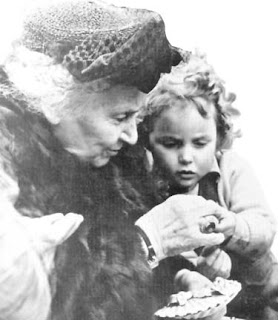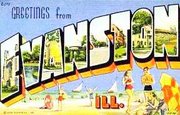Montessori
Il me semblait que la methode Montessori etait bien connue en France, mais a vos reactions, il semble que non. Alors voici un petit resume pompe sur le net, avec une photo de la Dame qui a bien secoue les idees recues (mange ta soupe et tais toi) en son temps.
Multi-aged Grouping, based on Periods of Development:
Children are grouped in three or six-year spans and have the same teacher for this period
The 3-Hour Work Period:
Aft every age, a minimum of one 3-hour work period per day, uninterrupted by required attendance at group activities of any kind is required for the Montessori method of education to produce the results for which it is famous.
The Human Tendencies: The practical application of the Montessori method is based on human tendencies— to explore, move, share with a group, to be independent and make decisions, create order, develop self-control, abstract ideas from experience, use the creative imagination, work hard, repeat, concentrate, and perfect one's efforts.
The Process of Learning:
There are three stages of learning:
(Stage 1) introduction to a concept by means of a lecture, lesson, something read in a book, etc.
(Stage 2) processing the information, developing an understanding of the concept through work, experimentation, creation.
(Stage 3) "knowing", to possessing an understanding of, demonstrated by the ability to pass a test with confidence, to teach another, or to express with ease.
Indirect Preparation:
The steps of learning any concept are analyzed by the adult and are systematically offered to the child. A child is always learning something that is indirectly preparing him to learn something else, making education a joyful discovery instead of drudgery.
The Prepared Environment:
The Prepared Environment: Since the child learns to glean information from many sources, instead of being handed it by the teacher, it is the role of the teacher to prepare and continue to adapt the environment, to link the child to it through well-thought-out lessons, and to facilitate the child's exploration and creativity.
Observation:
Scientific observations of the child's development are constantly carried out and recorded by the teacher. These observations are made on the level of concentration of each child, the introduction to and mastery of each piece of material, the social development, physical health, etc. on.
Work Centers:
The environment is arranged according to subject area, and children are always free to move around the room, and to continue to work on a piece of material with no time limit.
Teaching Method:
There are no text books, and seldom will two or more children be studying the same thing at the same time. Children learn directly from the environment, and from other children—rather than from the teacher. The teacher is trained to teach one child at a time, with a few small groups and almost no lessons given to the whole class. She is facile in the basic lessons of math, language, the arts and sciences, and in guiding a child's research and exploration, capitalizing on interests and excitement about a subject. Large groups occur only in the beginning of a new class, or in the beginning of the school year, and are phased out as the children gain independence. The child is scientifically observed, observations recorded and studied by the teacher. Children learn from what they are studying individually, but also from the amazing variety of work that is going on around them during the day.
Class Size:
The most successful 3-6 or 6-12 classes are of 30-35 children to one teacher, with one non teaching assistant, this number reached gradually over 1-3 years. This provides the most variety of personalities, learning styles, and work being done at one time. This class size is possible because the children learn from each other and stay with the same teacher for three to six years. .
Basic Lessons:
A well-trained Montessori teacher spends a lot of time during training practicing the many basic lessons with materials in all areas. She/he must pass difficult written and oral exams on these lessons in order to be certified. She is trained to recognize a child's readiness—according to age, ability, and interest—for a specific lesson, and is prepared to guide individual progress. Although the teacher plans lessons for each child for each day, she will bow to the interests of a child following a passion.
Areas of Study Linked:
All subjects are interwoven; history, art, music, math, astronomy, biology, geology, physics, and chemistry are not isolated from each other and a child studies them in any order he chooses, moving through all in a unique way for each child. At any one time in a day all subjects—math, language, science, history, geography, art, music, etc.—are being studied, at all levels.
The Schedule:
There is at least one 3-hour period of uninterrupted, work time each day, not broken up by required group lessons or lessons by specialists. Adults and children respect concentration and do not interrupt someone who is busy at a task. Groups form spontaneously but not on a predictable schedule. Specialists are available at times but no child is asked to interrupt a self-initiated project to attend these lessons.
Assessment:
There are no grades, or other forms of reward or punishment, subtle or overt. Assessment is by portfolio and the teacher's observation and record keeping. The real test of whether or not the system is working lies in the accomplishment and behavior of the children, their happiness, maturity, kindness, and love of learning, concentration, and work.
Requirements for Age 3-6:
There are no academic requirements for this age, but children are exposed to amazing amounts of knowledge and often learn to read, write and calculate beyond what is often thought usual for a child of this age.
Requirements for Ages 6-18:
Requirements for ages 6-18: There are no curriculum requirements except those set by the state, or college entrance requirements, for specific grades and these take a minimum amount of time. Students of K-12+ age design 1-2 week contracts with the teacher to balance their work, and learn time management skills. The work of the 6-12 class includes subjects usually not introduced until high school.
Learning Styles:
All intelligences and styles of learning—musical, bodily-kinesthetic, spatial, interpersonal, intrapersonal, intuitive, natural, and the traditional linguistic and logical-mathematical—are nurtured and respected.
Character Education:
Opportunities for the valorization of the personality is considered at least as important as academic education. Children are given the opportunity to take care of themselves, each other, and the environment—gardening, cooking, building, moving gracefully, speaking politely, doing social work in the community, etc.
The Results of learning in this way:
In looking at the results one must be sure they are judging a class run by a fully trained teacher. Using Montessori without this training will not have the same results. When the environment meets all of the needs of children they become, without any manipulation by the adult, physically healthy, mentally and psychologically fulfilled, extremely well-educated, and brimming over with joy and kindness toward each other. Here is an early quote by Dr. Montessori:
Personellement, je pense qu'il y a autant de styles que d'ecoles. La premiere ecole que j'ai visitee m'a fortement deplue (et en plus, elle coutait 18,000$ par an...). Il y avait un silence de mort, avec des gamins qui restaient les yeux dans le vide a rien faire. Dans la classe d'Alice, il y a effectivement des heures de "travail" le matin, mais ca danse la Macarena le soir!


No comments:
Post a Comment